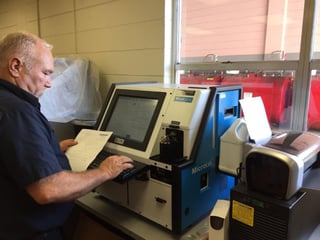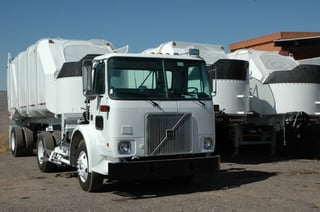Getting started with an on-site oil analysis program for Fleets
 We have worked with many fleets to bring oil analysis capability on site with the MicroLab® analyzer. The programs can be very successful in helping fleets save money by extending oil drain intervals and by identifying mechanical issues before they result in catastrophic failures.
We have worked with many fleets to bring oil analysis capability on site with the MicroLab® analyzer. The programs can be very successful in helping fleets save money by extending oil drain intervals and by identifying mechanical issues before they result in catastrophic failures.
There are several factors to consider when incorporating oil analysis into your maintenance routines so that it doesn’t put a burden on the workflow of normal operations:
Placement of the analyzer
- MicroLab does not require a lab environment but is best-suited to a clean, temperature-controlled room. Locating it in the garage bays can expose the analyzer to large temperature changes and a lot of dust and debris, which is not ideal for the best operation of the instrument.
- It should be close enough to the maintenance area that the mechanics don’t need to walk a long way to bring the samples over to the analyzer.
- We have seen successful programs where it is located inside a maintenance office or parts room located near the shop floor.
Operators for the analyzer
 The MicroLab is a very simple analyzer for anyone to operate but we have seen the most success when there are a small number of dedicated users. The main reason is that someone needs to be responsible for the care and maintenance of the analyzer. When this responsibility is poorly defined or spread out among many users the required maintenance steps can be skipped because no one is really dedicated to it.
The MicroLab is a very simple analyzer for anyone to operate but we have seen the most success when there are a small number of dedicated users. The main reason is that someone needs to be responsible for the care and maintenance of the analyzer. When this responsibility is poorly defined or spread out among many users the required maintenance steps can be skipped because no one is really dedicated to it.- We have seen successful programs in which the mechanic pulls the sample and then either an admin employee or a parts department staff member runs the analyzer.
Taking samples
- If you have been sending samples to an outside lab your mechanics are accustomed to pulling oil samples.
- It is best to take the oil sample at operating temperature. If you are taking the sample through the dipstick port don’t put the tubing all the way to the bottom. If you are taking the sample when you are draining the oil then let some oil run out before catching your sample so you don’t collect any sludge from the bottom of the pan.
- If oil analysis is new to your shop, we have seen successful programs where the mechanic starts by pulling an oil sample as a first step in the PM and then goes on to other safety checks while the sample is being run. When the oil results are complete, in about 10 minutes, the mechanic can review the report to know what other maintenance needs to be done.
Extending oil drain
 If you are just starting an oil analysis program and are considering extending oil drain intervals we recommend starting with one group or department of vehicles in your fleet – maybe just your police vehicles or your trash trucks. This allows you to concentrate on one area at a time because every group of vehicles will be different.
If you are just starting an oil analysis program and are considering extending oil drain intervals we recommend starting with one group or department of vehicles in your fleet – maybe just your police vehicles or your trash trucks. This allows you to concentrate on one area at a time because every group of vehicles will be different.- Next, establish a baseline by testing the oil in those vehicles every PM cycle for about 3-4 cycles to understand whether the oil consistently shows that it is still good for use with your current PM mileage or if it is indeed time to change it.
- If all oil condition parameters are in the normal range you can consider extending to the next PM cycle and retesting.
Other tips
- If oil analysis is new to your fleet you don’t have to start testing your entire fleet. Start with a small number of vehicles to get used to it and to see how it will benefit your maintenance practices.
- You can also start by testing a group of vehicles that has been experiencing higher levels of mechanical failures. Use oil analysis to help you get ahead of the failures.
- Spectro Scientific can assist in uploading your equipment list to the database in the analyzer, which saves time for the operator when they are entering the information about the sample.

